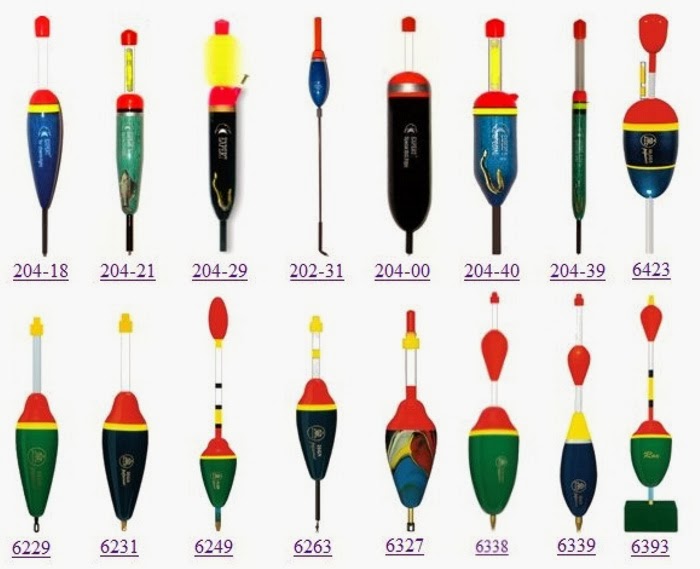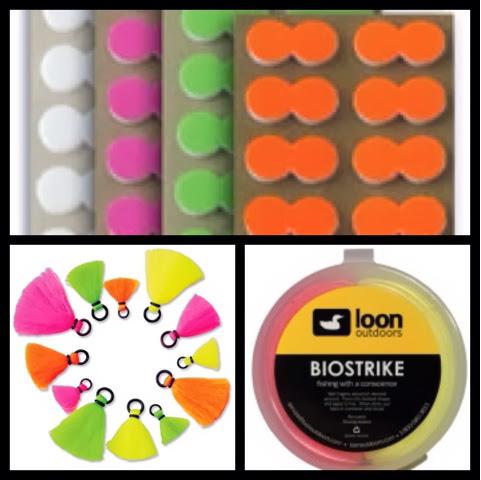Bobbers. That's what strike indicators
truly are. However, in the hierarchical flavor of many pretentious fly guys, the term "bobber" is reserved for the bait fishing basement dwellers of angling society and the pompous flingers of fur and feathers refer to the baby bobber as a strike indicator. This blog entry is intended to review different styles of strike indicators, cover some basic strike indicator placement, and to stop bobber bigotry. Bobbers are strike indicators too.
 |
| Just add batteries for night time brown poaching |
What Indicators to Avoid... like for real, don't use these
Personally I feel that putty indicators, sticker indicators, and big yarn indicators with rubber o-rings all suck.
 |
| Not my favs. Clockwise from the top: Stickers, putty, o-ring yarn. |
Putty leaves residue on your leader, doesn't float well, and doesn't work as well in the cold when you are most apt to use an indicator/bobber/nibble detector/eat-meter.
Sticker Indicators are wind resistant and cause drag when casting, leave sticky residue on your leader, and don't float well. Burn 'em.
Yarn Indicators with rubber o-rings are also very wind resistant and hard to keep floating. Too much silicone applied to them and they sink from the weight of the silicone and rubber o-ring. Too little silicone and they sink from water absorption.
My 3 favorite Strike Indicators ... (money makers)
My go to strike indicators are Lightning Strike football indicators, Thing-a-ma-bobbers, and Lefty Kreh's indicator yarn. None of these are perfect, hence the reason I have three favorites. I use these in different scenarios.
 |
| I likes the white footballs for their bubble camo qualities |
Lightning Strike Football Indicators are the indicator I fish the most often. Most of my fishing is for wily wild trout or over-pressured big trout. I only use the small white one. I think these small white football indicators spook less fish when they hit the water and are more apt to look like a air bubble when they float over the head of picky fish. The best thing about these indicators is that you can slide them up and down your leader to adjust for depth without taking it off or kinking your leader, making these little indicators worth their weight in wood duck flank feathers. This bitty bobber is not invincible though. The small ones don't float great with heavy nymphs or strong currents. Also, the white air bubble theory works reverse on the fisherman, because it can be harder to see than the fluorescent glowing beacon indicators out there. They can also be a little tricky to get on your leader; like wrasslin a greased pig.
 |
| the industry standard fly bobber |
Thingamabobber embraced the obvious about 10 years ago when their products stormed the market
and became the industry standard for fly fishing bobbers by calling a spade a spade. As it's name suggests, it's a bobber people. These things float high and they are easy to see and easy to use. Nuff said. Although these bright balls aren't aerodynamic, their heft allows them to punch through the air better than their light but clumsy yarn counterparts. If you get the bright colored ones, nothing is easier to see on the water. The kryptonite for the Thingamabobber is that it's loud to hit the water, can be easy to spot by educated trout who have previously felt the sting of a hook after watching the popular Thingamabobber float by, and they leave a sharp kink in your leader when you take them off or move them. I like to use these indicators when teaching people to nymph, fishing stocked trout with mush for brains, or when fishing deep water that needs and indicator to float high and keep your flies from snagging bottom or dropping deeper than where the fish are feeding.
 |
| best yarn indi if you go yarn |
Lefty Kreh's Strike Indicator Yarn is a super solid product. I use it for heavily pressured or spooky trout, particularly in low water situations. It dispenses in two twisted strands out of the top of a little cylinder, and I usually separate the strands and just cut a small piece from on strand. Just a tad of silicone will keep it riding high for a while, and this stuff floats really well, especially compared to other yarns out there. If you use both strands, you can float a heavy leaded nymph no problem. When it hits the water, it's as soft as a #18 adams dry flying laying down on the surface. It's the Ninja of bobbers. It's weaknesses are that you need a knife or scissors to cut a piece off, and the little girth hitch leaves a kink in your line. Also, you'll have to switch it out for a new piece a few times if you fish it all day. The plus side is its freakin' Ninja skills have helped me stick some big, smart trout.
Other strike indicators are out there for sure, and a lot of it boils down to personal preference. Czech nymphers use a piece of fluorescent amnesia type material in their leaders as an indicator. I haven't tried this style of strike indication yet, but I can see the merit in it. Fish Pimp makes a football type indicator as well that looks sexier than the lightning strike football packaging and product, but I haven't tried those either.
Bobber Basics
The simple rule of thumb is that you estimate the water depth, multiply by two, then place your indicator that distance from your lead fly. If the water is 3 feet deep, place your indicator 6 feet up your leader from your fly. This is assuming you are trying to get your fly to the bottom of the river. Another rule of thumb is if you aren't occasionally get hung up on the bottom, you probably aren't deep enough. Add weight or adjust your indicator.
The biggest variable in the twice-the-depth-of-the-water formula is current speed. If the water is ripping through a run, you need to place your indicator further from your lead fly to allow it time to sink deeper (If I am fishing two of three flies, I consider the fly that is closest to my fly line the lead fly). Counter to fast water, in slow water, you may need to slide your indicator down closer to your rig to prevent it from sinking like a rock and hanging up before your drift even makes it to the feeding lane. Beware! In slow water the fish are more wary and have more time to examine you flies, and an indicator closer to your set up may be enough for educated or spooky trout to move into the lock-jaw state, and kill your chance of an eat.
There you have it. Josh Jones' bobber bonanza. Remember these are only my opinions, and if you don't care for the opinion of a dead sexy, expert fly fisherman with chiseled abs and credentials to make anglers around the world blush...then your in luck, 'cause I'm just the local idiot. Happy bobber fishing rednecks.











